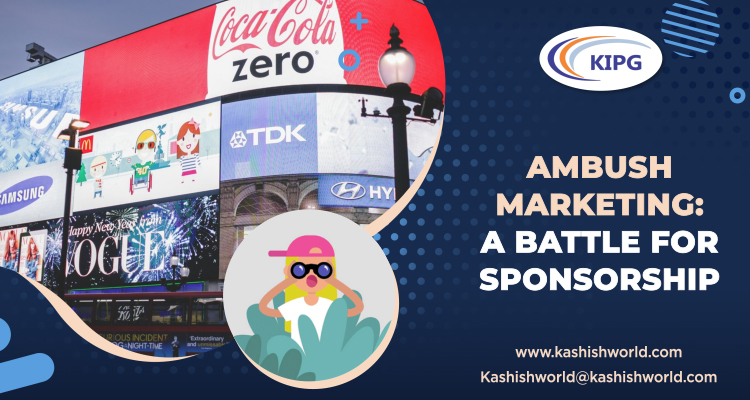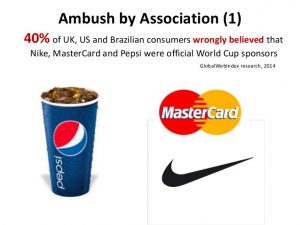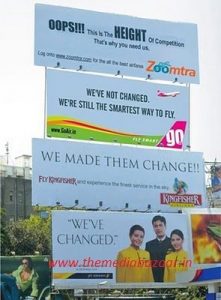
What is Ambush Marketing?
Ambush marketing is popularly known as coat-tail marketing or predatory ambushing, which is a practice of hijacking or co-opting another enterpriser’s campaign to raise awareness of the ambushing company itself. It may occur by independent attacks in furtherance of attracting consumers’ attention in general or may occur concerning a particular event where there is no clear divide between the sponsors and non-sponsors. The main aim of ambush advertisers is to deceive the customers into believing that they have an official association with the event without using the trademarks of third parties. Another aim is to attack the other for stealing its spotlight and liquidate the capital, effort, and resources spent by it.
In simple words, it occurs when a particular brand owner makes an attempt to associate himself or herself with a particular event without paying for a sponsorship fee or tries to stifle the competition by intervening in the market practice adopted by that other. The same is generally observed during giant sports events like Super Bowls, IPL, World Cups, Common Wealth Games, etc., which can cause a hurdle for those who are the genuine sponsors of the said event. Consider the example of the Cricket World Cup where companies race for the tag of an ‘official sponsor,’ which costs them about $1.1 billion. PepsiCo got the deal of being a ‘Title Sponsor’ at a heavy bet of Rupees four hundred (400) crores for a five-year timeline. As mentioned above, it also may be generally deployed. An example of this is the battle between Audi and BMW for establishing billboard dominance. Here, Audi launched its A4 sedan while mocking BMW by saying, “Your move, BMW“ – to which BMW responded by erecting a billboard beside the BMW poster saying, ‘Checkmate,’ announcing its series of new sedans.

The question of ambush marketing as a legitimate marketing practice is often questioned since it impacts and creates negative tension while demotivating official sponsors by violating their rights. It is, therefore, not the best method of marketing to attract consumers through honest business practices.
Why does an Enterprise Opt for Ambush Marketing?

- Enforcement Issues: Enterprises go ahead with ambush marketing for events that generally attract a greater audience for the timeframe of the event, which is usually two to three days. It becomes difficult for the event organizers to exercise their legal options to prohibit such activity and receive quick redressal of their problems.
- Lack of Legal Jurisprudence: The prevalent laws for ambush marketing are very generic in nature. Moreover, as the judicial process requires a lot of effort and is time-consuming, only a few companies file infringement suits against ambush marketers. Also, since there is a lack of legal precedents and jurisprudence on the said matter, brands are reluctant to file lawsuits due to the ambiguity and uncertainty in the said domain.
- Use of Disclaimers: Companies are putting up disclaimers stating that they are not the official sponsors of the said event to flee from potential infringement. Therefore, they continuously utilize the option of ambush marketing in favor of attracting the mass populace (consumers) without facing any legal trouble.
Kinds of Ambush Marketing

- Direct Ambushing: The most serious and offensive form of ambush marketing is the one that is direct in nature. In this kind of marketing, a brand intentionally connects itself to an event to appear as though it is affiliated to the event in which it has no rights, which directly attacks the rivals and authorized brands. It may be deployed by making unauthorized use of symbols (trademarks) or marketing elements by the infringing company. An example of this is the marketing strategy deployed by Sprints Communication Co. in the FIFA Football World Cup, as it used the event’s official logo without the permission of the governing body. Also, while Nike was not the official sponsor for Olymics’96, it had put up massive billboards outside the stadium to deceive the audience into believing that it was the sponsor. Direct ambush marketing can take various forms, which are explained below:
- Predatory Ambushing: It occurs when a company directly enters into a conflict with the competitor, due to which confusion surfaces around the actual official sponsor of the event. The same happened during the Winter Games’94 when Visa and American Express came face to face. Although Visa had the official sponsorship, American Express succeeded in touching the nerves of Amex, which did create a lot of confusion amongst the masses.
- Coattail Ambushing: It occurs when the official sponsor is over-shadowed by the non-sponsors in a given event. An example of this is when Lindford Christie wore PUMA’s eyewear during the press conference while Reebok was the real sponsor. Puma stole the thunder of the authorized sponsor.
- Indirect Ambushing: It occurs when a company attaches itself to another parent advertiser. It is a much more indirect and unaggressive manner of pursuing their marketing ambition. It can also take up many other forms, which are as follows:

- Associative Ambushing: It happens by intentionally using such terms or imagery, which portray that the said company has links to the parent advertiser without mentioning or giving reference to the official sponsorship. An example of this is when Beat Electronics introduced a campaign during Olympic Games in London where it said it would provide free headphones to athletes who wore them at the venue where the event was taking place or tweeted about them.
- Distractive Ambushing: It happens when companies use the main theme and values of the sponsorship holding company to trick people into believing that they’re the same company while actually, they’re not.
- Insurgent Ambushing: When companies and individuals surprise the public with their unique promotional techniques, it is termed insurgent ambushing. Their indirect presence doesn’t hurt the reputation of the prime brand or sponsor. But, they do get a lot of attention for their brand in return.
Ambushing Marketing and Trademarks
The trademark legislations generally include a device, brand, heading, label, ticket, name, a combination of colors, etc., within the ambit of a ‘mark.’ The same should be capable of being represented graphically and be competent to distinguish the goods or services of one person from those of the others and include the shape of goods, their packaging and the combination of colors. It is for this reason that the law allows the companies sponsoring the event and the ‘game committees’ to register their labels or marks as trademarks.
The intermingling role of trademarks is very obvious when it comes to ambush marketing. It is because of the following two reasons:
- The Trademark Law protects the goodwill of a particular company, which it has garnered and nurtured over the years.
- The law also protects the common man from being deceived or from probable confusion concerning the origin or source of a particular good or service.
Therefore, where anyone makes authorized use of a logo or mark, the question of Trademark Infringement automatically walks in.

The interplay of trademarks was visible in the Arsenal Football Club Plc vs. Matthew Reed case where Arsenal Football club was the registered proprietor of the trademark ‘ARSENAL’ used concerning the team, cannon devices, etc. The defendant was selling souvenirs and club merchandise bearing the said Registered Trademark without obtaining a license or prior authorization from the Football Club. The Club brought an action against Matthew Reed alleging trademark infringement and passing off. Arsenal lost its claim on passing off since it failed to substantiate its claims through reasonable evidence suggesting the existence of confusion. Mr. Reed’s defense to the claim for trademark infringement laid in the argument was that his use of the Arsenal Mark did not amount to ‘trademark use’ or ‘use indicating trade origin’ but merely as badges of allegiance. The European Court of Justice ruled in favor of Mr. Reed; however, on appeal to the Court of Appeal, the Court rightly rejected Reed’s contentions and ruled in favor of Arsenal.
However, the trademark legislation in itself may not sufficiently provide for a remedy against ambush marketing since, in most cases, ambushers do not make direct use of the trademarks or insignias of the legit sponsors. Instead, they usually refer to the sponsors or the games in their products or services ingeniously and creatively to circumvent the law. Therefore, the said issue should be dealt with within the law governing the sphere of Unfair Competition since Article 10bis of the Paris Convention states that “the countries of the Union are bound to assure to nationals of such country’s effective protection against unfair competition.” There are a few nations that have promulgated legislation to curb the practice. A few of these nations include New Zealand, China, and the United Kingdom.
Concluding Remarks:
How to Curb the Practice where Different Sponsors and Non-Sponsors are Involved?

Like patent trolling takes place in the domain of patents, in the same fashion, trademark bullying occurs in the domain of trademarks. Trademark bullying may take many forms, out of which one is ‘ambush marketing.‘ Therefore, when a rightful sponsor pays handsomely for exclusively advertising its products or services under its own trademark/name, it shall have the right to prevent and stop a competitor who is not an authorized sponsor from stealing that benefit. The following are a few steps that a marketer can take against an enterprise pursuing such unfair business practices:
- It is crucial to anticipate and monitor one’s competitors’ marketing practices.
- While negotiating a sponsorship deal with the event managers, it is imperative to agree and address the course of action to be taken in response to such marketing.
- For deterring such marketers, pre-event publicity by the organizer of the event condemning the practice of ambushing advertising can be pursued.
- The event managers and organizers should be requested to prepare draft court papers to address the ambushing and snip it from its roots as a cease and desist letter would not solve the issue within such a short period.
- The event organizers should take into consideration the request of their authorized sponsors by relying on antecedent events and pieces of evidence against their competitors.
- The event organizer should establish clean zones where the event is happening, which should be beyond the reach of non-sponsor advertisers.
As can be observed, the rightful sponsor can help identify the mischievous ambush marketers, but the other end of the rope is hooked by the event organizers only. The reason for imposing an obligation on the event organizers helps in rapport and image formation to attract better sponsors in the future. Therefore, to contain the practice, careful and anticipatory planning in advance to responding to such ambushing or safeguarding one’s legitimate premise through preparation by a legal action team can help shift back the focus to the rightful sponsor. Lawyers can help ensure that in the tit-for-tat, the sponsor does not itself stumble into trouble by helping it avoid infringement, unfair competition, and product disparagement claims.

